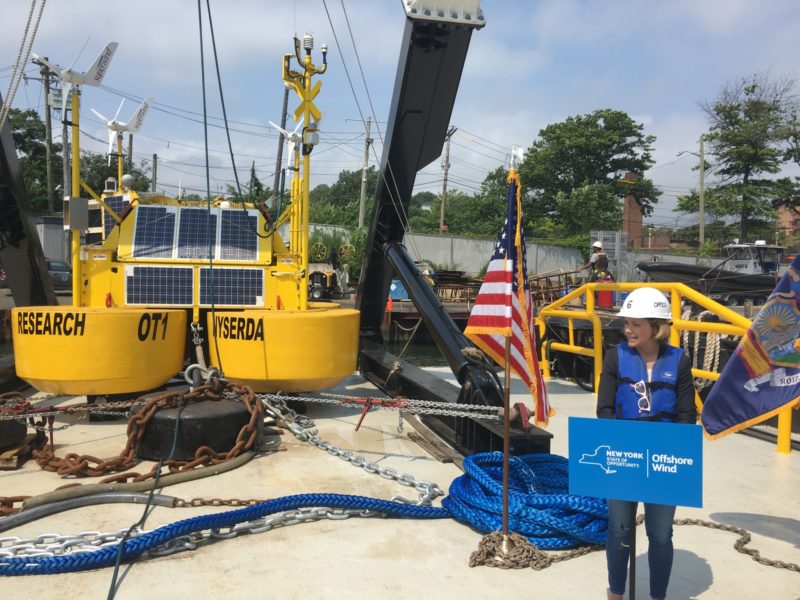New York state energy officials announced Thursday more than $2 million has been allocated for new studies on how offshore wind energy development will affect fisheries and wildlife.
The projects include joint efforts with the Responsible Offshore Development Alliance, a coalition of East Coast fishing and seafood industry groups that has been advocating for the state and federal governments to move more cautiously on proposals for massive turbine arrays in Northeast and Mid-Atlantic waters.
The next studies continue offshore environmental surveys begun in 2017 by the New York State Energy Research and Development Authority, including digital aerial surveys of birds, marine mammals, sharks and fish shoals that concluded in spring 2019 after collecting more than 3.5 million images across the New York Bight.
NYSERDA originally set out with 20 studies of environmental, social, economic and regulatory issues with building offshore wind power in one of the nation’s busiest seaways. The new studies will build on that with more environmental, maritime and social issues to analyze.
The energy authority held a competitive solicitation for proposals in five categories: ecosystem dynamics, commercial fishing access, best approaches monitoring offshore wind projects before and after construction, how to best use “nontraditional data” — effectively including fishermen’s local knowledge in decision making — and modeling effects of offshore wind developments.
Bringing fishermen inside the process is an “opportunity to develop an industry-driven data infrastructure, allowing fishermen’s extensive knowledge to be better incorporated into decision making while retaining their individual privacy,” said Annie Hawkins, executive director of the Responsible Offshore Development Alliance, in a joint statement with NYSERDA.
“We believe this will be a major contributor to de-conflicting multiple ocean uses and appreciate NYSERDA’s recognition of the importance of our fishing communities’ deep expertise regarding ocean ecosystems,” she said.
Groups chosen for the work include fishermen, federal energy and wildlife experts, and environmental researchers:.
National Renewable Energy Laboratory with the Responsible Offshore Development Alliance and others — Collaborative development of strategies and tools to address commercial fishing: A two-year, $500,000 project to address the need to understand and develop solutions for safe and efficient access to fishing grounds, while also ensuring that offshore energy projects meet their operational goals.
Responsible Offshore Development Alliance — Creation of a Data Trust for effective inclusion of fishermen’s knowledge in offshore wind energy decision making: A one-year, nearly $300,000 project to develop high-quality, evidence-based science products that can improve decision-making for offshore wind development, with additional benefits for ecosystem-based assessment and fisheries stock assessment and management.
Biodiversity Research Institute — Multiscale relationships between marine predators and forage fish: A three-year, nearly $500,000 project designed to better understand the linkages between forage fish such as menhaden and seabirds, and implications of offshore wind development on seabird behaviors and distribution.
Ecology and Environment — Environmental and fisheries research for offshore wind: an 18-month, $500,000 project to develop spatially and temporally dynamic information about the distribution of oceanographic characteristics in the New York Bight through the development and application of a dedicated multiyear 3-D flow model to wildlife distribution movements.
U.S. Fish and Wildlife Service — Development of monitoring protocols for nanotag studies at offshore wind farms: A two-year, nearly $300,000 project to develop standardized guidelines to inform the use of miniature digitally-coded VHF (very high frequency) transmitters to monitor birds and bats in relation to offshore wind energy development.
The wildlife service will work with the University of Rhode Island, Bird Studies Canada, and the Bureau of Ocean Energy Management to develop standardized protocols for tracking avian and bat movements offshore, said Pamela Loring, a Fish and Wildlife Service biologist.
NYSERDA is also looking for a state offshore wind fisheries liaison to help its planners expand outreach and engagement with commercial and recreation fishing communities across the region and into southern New England. The deadline for applications is Aug. 19, 2019.







